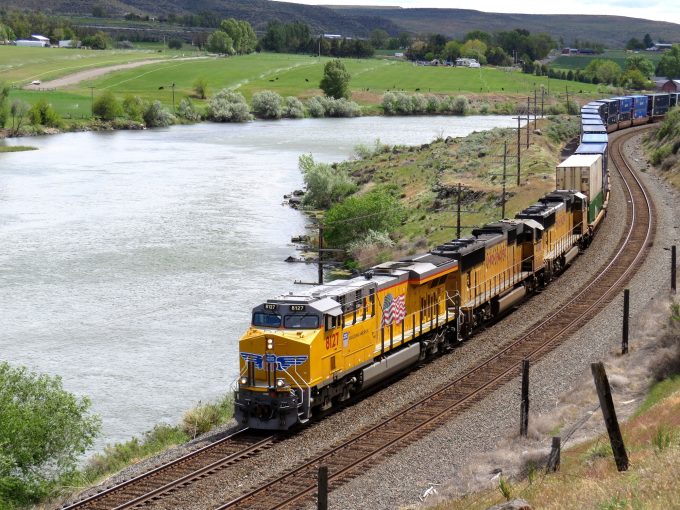New STB chair orders railway CEOs to attend forum on declining volumes
Robert Primus, the new chairman of the US Surface Transportation Board (STB), has called in ...
TFII: SOLID AS USUALMAERSK: WEAKENINGF: FALLING OFF A CLIFFAAPL: 'BOTTLENECK IN MAINLAND CHINA'AAPL: CHINA TRENDSDHL: GROWTH CAPEXR: ANOTHER SOLID DELIVERYMFT: HERE COMES THE FALLDSV: LOOK AT SCHENKER PERFORMANCEUPS: A WAVE OF DOWNGRADES DSV: BARGAIN BINKNX: EARNINGS OUTODFL: RISING AND FALLING AND THEN RISING
TFII: SOLID AS USUALMAERSK: WEAKENINGF: FALLING OFF A CLIFFAAPL: 'BOTTLENECK IN MAINLAND CHINA'AAPL: CHINA TRENDSDHL: GROWTH CAPEXR: ANOTHER SOLID DELIVERYMFT: HERE COMES THE FALLDSV: LOOK AT SCHENKER PERFORMANCEUPS: A WAVE OF DOWNGRADES DSV: BARGAIN BINKNX: EARNINGS OUTODFL: RISING AND FALLING AND THEN RISING

One minute before midnight on Sunday, Class I rail operator Union Pacific (UP) slammed on the brakes and halted intermodal services from west coast ports to its Global IV terminal near Chicago.
The embargo affects the ports of Long Beach, Los Angeles, Oakland and Tacoma and will last up to seven days.
UP is moving containers out of ports that were booked before the embargo, but is not confirming new reservations for the time being.
The measure aims to reduce the chronic congestion that has plagued UP’s Global IV facility. The railway informed customers it was necessary to tackle the “significant congestion at our inland intermodal terminals, most notably in Chicago”.
Not surprisingly, given its role as the largest rail hub in the US, Chicago has been at the epicentre of congestion that has spread through rail networks. There have been reports of containers stuck in Chicago for six or seven weeks.
UP’s latest move is the most dramatic action by a railway to grapple with congestion – but the other Class I railways have also had to resort to serious measures.
This month, Norfolk Southern (NS) decimated the number of domestic containers it accepted on four busy routes, caused chiefly by a shortage of chassis and rampant demand. This banned intermodal marketing companies (IMCs) from tendering domestic loads on routes from Chicago, Kansas City, Memphis and St Louis to Bethlehem, Pennsylvania.
The move followed emergency service cuts on two dozen lanes NS had announced in late June.
CSX has slashed the number of reservation slots from Bedford Park to Chicago, and BNSF has used allocation caps for IMCs.
One reflection of the overburdened rail network is a sharp rise in the number of transloads of import containers from the west coast to the midwest.
Trucking is similarly strained, however. Shippers have reported embargoes, limits and surcharges used by providers to control capacity, scenarios that are frequently playing out in the parcel and LTL sectors.
The American Trucking Association reported a 0.2% decline in truck freight for May, noting that this was due not to slackening demand, but to capacity constraints caused by congestion in the system. In May the ratio of available loads to capacity postings was 6.1 to one, up from 4.8 in April.
Along the same lines, the Cass report for June shows a 3% drop in shipping volumes from the previous month, caused by tight road and intermodal capacity.
“Recent industry discussions suggest shipment volumes continue to be hindered by supply constraints, which range from driver and trailer shortages in truckload and less-than-truckload to chassis shortages hampering intermodal capacity,” the freight audit firm wrote in its report.
As shipment volumes declined in June, pricing continued to rise, climbing 11%, CASS noted. Shippers and observers have reported broad rate increases across all modes of transport.
Adding insult to injury, shippers and consignees have been hit with high demurrage fees for containers buried at rail facilities. The rising noise of protests prompted UP to cap its demurrage fee at $2,450 per container.
Now, the problems inland are pushing back into the ports, reversing gains their efforts to lift productivity and ease congestion had shown.
At the Los Angeles/Long Beach port complex, container dwell times as well as truck turn times deteriorated at the most recent counts in May and June respectively. The number of vessels at anchor was up, at 18 early last week, having previously sunk to 10 – even though the port of Los Angeles now works 15 containerships a day, compared with 10 a day before Covid-19.
Meanwhile, imports remain strong. Data from the National Retail Federation show import volumes up 19% over June 2019. The organisation projects they will continue to climb until mid-August and then ease gradually, but still with double-digit increases over 2019.
At a media briefing last week, Gene Seroka, CEO of the port of LA, noted that early peak traffic was already coming in, indicating that some retailers moved early to avoid delays. He expects the full peak traffic from August through October.
By all indications, the rise in volumes will increase the strain on infrastructure, causing more delays and capacity bottlenecks.
Comment on this article